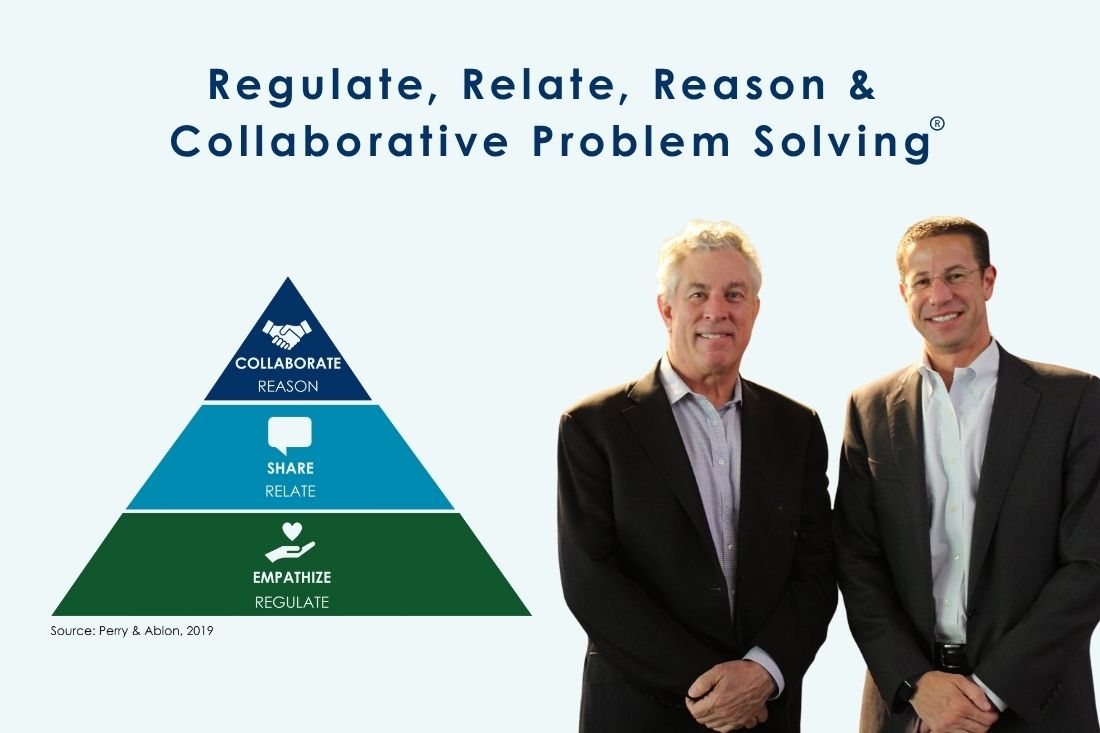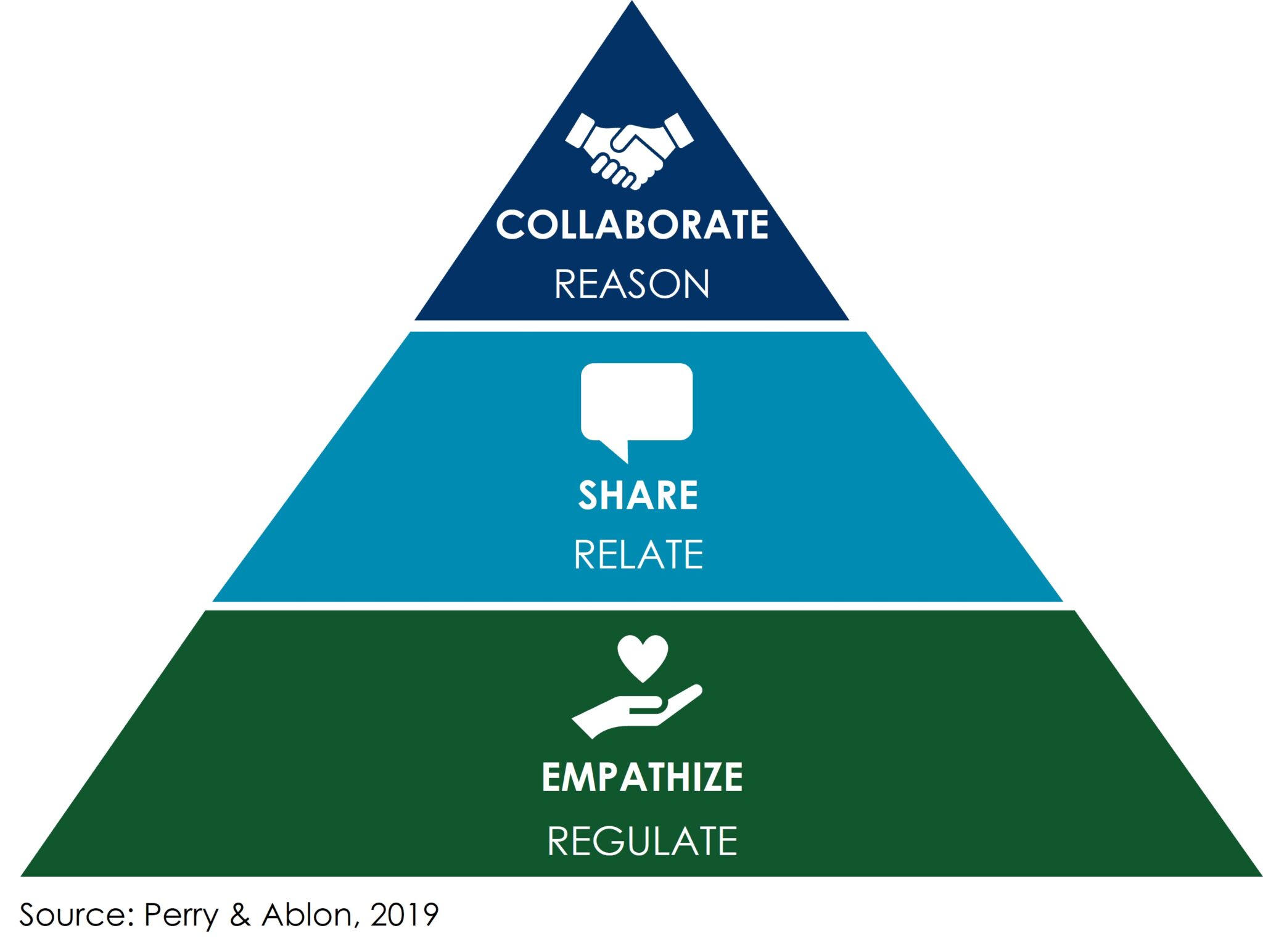
Dr. Bruce Perry, Principal of the Neurosequential Network, is a pioneer in understanding the impact that chronic stress and trauma have on brain development and behavior (Perry & Pollard, 1998). He has written three books, The Boy Who Was Raised as a Dog, Born for Love, and What Happened to You, that provide insight into the neurodevelopmental impact of trauma and what makes for trauma-informed care.
Dr. Perry’s work has been especially impactful by making complicated concepts more accessible. He helps us understand that the brain develops and organizes itself in a predictable, hierarchical sequence, starting with lower brain functions that allow us to regulate our state of arousal and moving to more complex functions like thinking skills. He teaches a simple rubric to help us remember this sequence: Regulate, Relate, Reason. We humans must be regulated or calm enough before we can relate to or appreciate another person’s perspective, before we can then use our reasoning skills.

Dr. Perry is careful to clarify that his Neurosequential Model, like any model, is an overly simplistic representation of the unendingly complex set of structures and processes that are found and occur in our brain. But conceptually, the sequence of “regulate, relate, reason” is crucial to remember. Parents, educators, and clinicians can all attest to the fact that no child will be able to take someone else’s perspective into account or reason with them if they are dysregulated.
Thus, if adults hope to access the “smart” part of a child’s brain–their prefrontal cortex–they need to start lower down in the brain first. By regulating a child first, adults can then see if the child is able to appreciate another perspective before ultimately hoping to access the child’s higher-order thinking skills so that they can reason.
One of the reasons the Collaborative Problem Solving® approach pairs so well with Dr. Perry’s Neurosequential Model is that our problem-solving process turns these concepts into concrete actions when talking to kids–or anyone else, for that matter (Perry & Ablon, 2018). The three ingredients of the Collaborative Problem Solving process provide a clear guide to adhere to the sequence of “regulate, relate, reason.” If one follows the ingredients in the right order, it ensures we respect the neurobiological sequence with which our brains process information.
REGULATE with Empathy:
The first ingredient of the Collaborative Problem Solving process is when you use empathy and curiosity to work hard to understand the child’s perspective, point of view, or concern. Empathy–being understood and listened to–is regulating.
RELATE by Sharing your perspective and asking the child to consider it:
The second ingredient in Collaborative Problem Solving is when you share your perspective or concern. We teach adults to only do that once they have first regulated the child by understanding where they are coming from. If the child becomes dysregulated and gets upset or shuts down when the adult shares their concern, more regulation is needed before the child will be ready to relate to someone else’s point of view. In other words, adults should retreat back to the first ingredient to re-regulate the child before proceeding again to the second ingredient by asking the child to relate to their perspective.

REASON by Inviting the child to brainstorm solutions together:
Once, and only once, the child can hear the adult perspective (in other words, relate to it), then you can move to the third and final ingredient by inviting the child to use their reasoning skills to problem solve.
Regulate, Relate, Reason–in that order. Empathize, Share your concern, Brainstorm together.
Dr. Perry helps us understand why this process is so powerful and effective–because it respects the sequence with which our brains process information. Collaborative Problem Solving puts the process into action!
| Cookie | Duration | Description |
|---|---|---|
| __cf_bm | 1 hour | This cookie, set by Cloudflare, is used to support Cloudflare Bot Management. |
| __hssc | 1 hour | HubSpot sets this cookie to keep track of sessions and to determine if HubSpot should increment the session number and timestamps in the __hstc cookie. |
| __hssrc | session | This cookie is set by Hubspot whenever it changes the session cookie. The __hssrc cookie set to 1 indicates that the user has restarted the browser, and if the cookie does not exist, it is assumed to be a new session. |
| cookielawinfo-checkbox-advertisement | 1 year | Set by the GDPR Cookie Consent plugin, this cookie records the user consent for the cookies in the "Advertisement" category. |
| cookielawinfo-checkbox-analytics | 11 months | This cookie is set by GDPR Cookie Consent plugin. The cookie is used to store the user consent for the cookies in the category "Analytics". |
| cookielawinfo-checkbox-functional | 11 months | The cookie is set by GDPR cookie consent to record the user consent for the cookies in the category "Functional". |
| cookielawinfo-checkbox-necessary | 11 months | This cookie is set by GDPR Cookie Consent plugin. The cookies is used to store the user consent for the cookies in the category "Necessary". |
| cookielawinfo-checkbox-others | 11 months | This cookie is set by GDPR Cookie Consent plugin. The cookie is used to store the user consent for the cookies in the category "Other. |
| cookielawinfo-checkbox-performance | 11 months | This cookie is set by GDPR Cookie Consent plugin. The cookie is used to store the user consent for the cookies in the category "Performance". |
| CookieLawInfoConsent | 1 year | CookieYes sets this cookie to record the default button state of the corresponding category and the status of CCPA. It works only in coordination with the primary cookie. |
| viewed_cookie_policy | 11 months | The cookie is set by the GDPR Cookie Consent plugin and is used to store whether or not user has consented to the use of cookies. It does not store any personal data. |
| Cookie | Duration | Description |
|---|---|---|
| li_gc | 6 months | Linkedin set this cookie for storing visitor's consent regarding using cookies for non-essential purposes. |
| lidc | 1 day | LinkedIn sets the lidc cookie to facilitate data center selection. |
| UserMatchHistory | 1 month | LinkedIn sets this cookie for LinkedIn Ads ID syncing. |
| Cookie | Duration | Description |
|---|---|---|
| __hstc | 6 months | Hubspot set this main cookie for tracking visitors. It contains the domain, initial timestamp (first visit), last timestamp (last visit), current timestamp (this visit), and session number (increments for each subsequent session). |
| _ga | 1 year 1 month 4 days | Google Analytics sets this cookie to calculate visitor, session and campaign data and track site usage for the site's analytics report. The cookie stores information anonymously and assigns a randomly generated number to recognise unique visitors. |
| _ga_* | 1 year 1 month 4 days | Google Analytics sets this cookie to store and count page views. |
| _gat_gtag_UA_* | 1 minute | Google Analytics sets this cookie to store a unique user ID. |
| _gid | 1 day | Google Analytics sets this cookie to store information on how visitors use a website while also creating an analytics report of the website's performance. Some of the collected data includes the number of visitors, their source, and the pages they visit anonymously. |
| AnalyticsSyncHistory | 1 month | Linkedin set this cookie to store information about the time a sync took place with the lms_analytics cookie. |
| CONSENT | 2 years | YouTube sets this cookie via embedded YouTube videos and registers anonymous statistical data. |
| hubspotutk | 6 months | HubSpot sets this cookie to keep track of the visitors to the website. This cookie is passed to HubSpot on form submission and used when deduplicating contacts. |
| vuid | 1 year 1 month 4 days | Vimeo installs this cookie to collect tracking information by setting a unique ID to embed videos on the website. |
| Cookie | Duration | Description |
|---|---|---|
| bcookie | 1 year | LinkedIn sets this cookie from LinkedIn share buttons and ad tags to recognize browser IDs. |
| bscookie | 1 year | LinkedIn sets this cookie to store performed actions on the website. |
| li_sugr | 3 months | LinkedIn sets this cookie to collect user behaviour data to optimise the website and make advertisements on the website more relevant. |
| NID | 6 months | Google sets the cookie for advertising purposes; to limit the number of times the user sees an ad, to unwanted mute ads, and to measure the effectiveness of ads. |
| test_cookie | 15 minutes | doubleclick.net sets this cookie to determine if the user's browser supports cookies. |
| VISITOR_INFO1_LIVE | 6 months | YouTube sets this cookie to measure bandwidth, determining whether the user gets the new or old player interface. |
| YSC | session | Youtube sets this cookie to track the views of embedded videos on Youtube pages. |
| yt-remote-connected-devices | never | YouTube sets this cookie to store the user's video preferences using embedded YouTube videos. |
| yt-remote-device-id | never | YouTube sets this cookie to store the user's video preferences using embedded YouTube videos. |
| yt.innertube::nextId | never | YouTube sets this cookie to register a unique ID to store data on what videos from YouTube the user has seen. |
| yt.innertube::requests | never | YouTube sets this cookie to register a unique ID to store data on what videos from YouTube the user has seen. |
| Cookie | Duration | Description |
|---|---|---|
| __Secure-YEC | 1 year 1 month | Description is currently not available. |
| _cfuvid | session | Description is currently not available. |
| _pk_id.d014234b-506e-4c9f-8f74-9ecfcde5874f.838e | 1 hour | Description is currently not available. |
| _pk_ses.d014234b-506e-4c9f-8f74-9ecfcde5874f.838e | 1 hour | Description is currently not available. |
| cf_clearance | 1 year | Description is currently not available. |
| ppms_privacy_d014234b-506e-4c9f-8f74-9ecfcde5874f | 1 year | Description is currently not available. |
| VISITOR_PRIVACY_METADATA | 6 months | Description is currently not available. |

